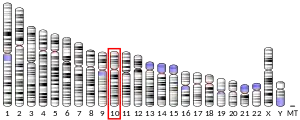DNA2L
DNA2-like helicase is an enzyme that in humans is encoded by the DNA2 gene.[5][6][7] Dna2, a homolog of DNA2KL present in budding yeast, possesses both helicase and nuclease activity, with which it helps catalyze early steps in homologous recombination.[8]
References
- GRCh38: Ensembl release 89: ENSG00000138346 - Ensembl, May 2017
- GRCm38: Ensembl release 89: ENSMUSG00000036875 - Ensembl, May 2017
- "Human PubMed Reference:". National Center for Biotechnology Information, U.S. National Library of Medicine.
- "Mouse PubMed Reference:". National Center for Biotechnology Information, U.S. National Library of Medicine.
- Eki T, Okumura K, Shiratori A, Abe M, Nogami M, Taguchi H, Shibata T, Murakami Y, Hanaoka F (Mar 1997). "Assignment of the closest human homologue (DNA2L:KIAA0083) of the yeast Dna2 helicase gene to chromosome band 10q21.3-q22.1". Genomics. 37 (3): 408–10. doi:10.1006/geno.1996.0581. PMID 8938459.
- Masuda-Sasa T, Polaczek P, Campbell JL (Dec 2006). "Single strand annealing and ATP-independent strand exchange activities of yeast and human DNA2: possible role in Okazaki fragment maturation". J Biol Chem. 281 (50): 38555–64. doi:10.1074/jbc.M604925200. PMID 17032657.
- "Entrez Gene: DNA2L DNA2 DNA replication helicase 2-like (yeast)".
- Mimitou, EP; Symington, LS (May 2009). "Nucleases and helicases take center stage in homologous recombination". Trends in Biochemical Sciences. 34 (5): 264–272. doi:10.1016/j.tibs.2009.01.010. PMID 19375328.
Further reading
- Masuda-Sasa T, Imamura O, Campbell JL (2006). "Biochemical analysis of human Dna2". Nucleic Acids Res. 34 (6): 1865–75. doi:10.1093/nar/gkl070. PMC 1428797. PMID 16595800.
- Kim JH, Kim HD, Ryu GH, et al. (2006). "Isolation of human Dna2 endonuclease and characterization of its enzymatic properties". Nucleic Acids Res. 34 (6): 1854–64. doi:10.1093/nar/gkl102. PMC 1428795. PMID 16595799.
- Gerhard DS, Wagner L, Feingold EA, et al. (2004). "The Status, Quality, and Expansion of the NIH Full-Length cDNA Project: The Mammalian Gene Collection (MGC)". Genome Res. 14 (10B): 2121–7. doi:10.1101/gr.2596504. PMC 528928. PMID 15489334.
- Deloukas P, Earthrowl ME, Grafham DV, et al. (2004). "The DNA sequence and comparative analysis of human chromosome 10". Nature. 429 (6990): 375–81. doi:10.1038/nature02462. PMID 15164054.
- Strausberg RL, Feingold EA, Grouse LH, et al. (2003). "Generation and initial analysis of more than 15,000 full-length human and mouse cDNA sequences". Proc. Natl. Acad. Sci. U.S.A. 99 (26): 16899–903. doi:10.1073/pnas.242603899. PMC 139241. PMID 12477932.
- Nagase T, Miyajima N, Tanaka A, et al. (1995). "Prediction of the coding sequences of unidentified human genes. III. The coding sequences of 40 new genes (KIAA0081-KIAA0120) deduced by analysis of cDNA clones from human cell line KG-1". DNA Res. 2 (1): 37–43. doi:10.1093/dnares/2.1.37. PMID 7788527.
This article is issued from Wikipedia. The text is licensed under Creative Commons - Attribution - Sharealike. Additional terms may apply for the media files.




